Apps Hosting in Public vs Private Clouds
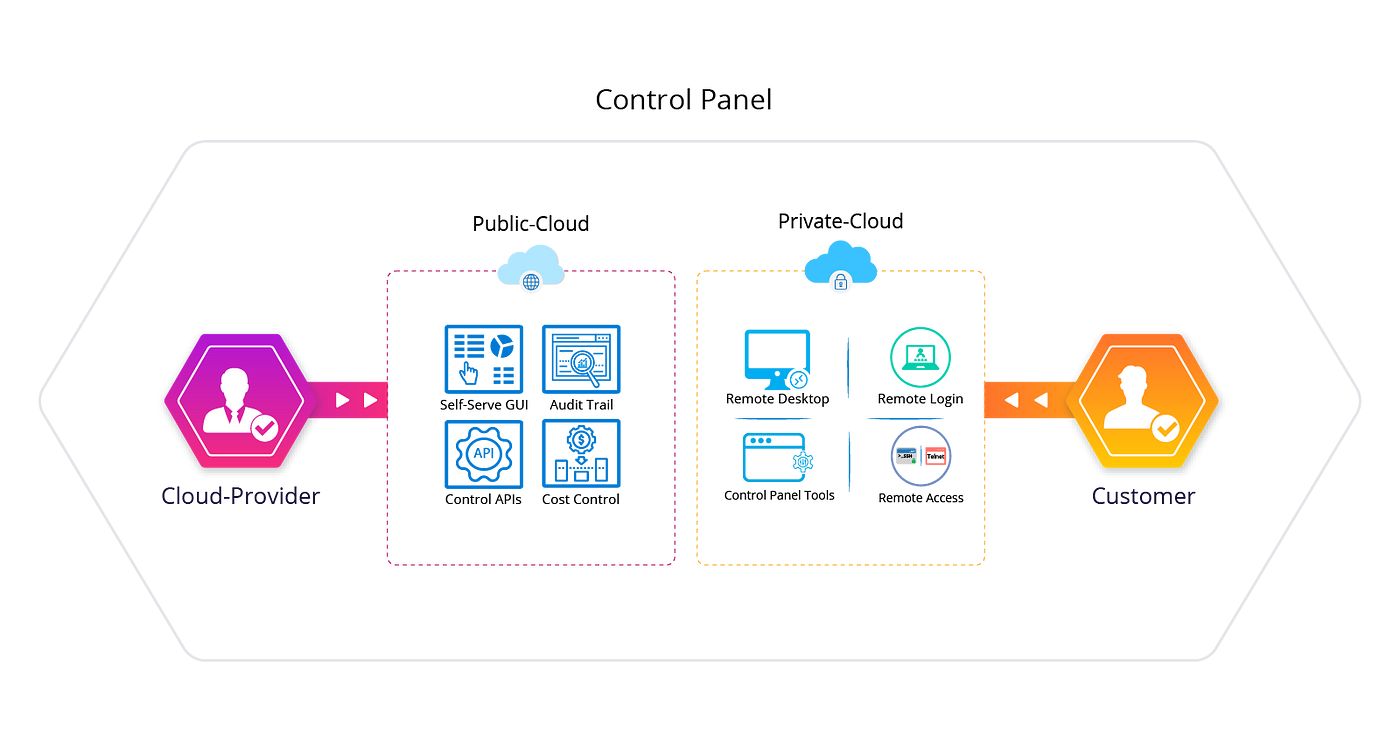 |
| Apps Hosting in Public vs Private Clouds |
Cloud-Providers offer applications and services hosted in the cloud. They always provide and manage the infrastructure which consists of compute, storage and networking resources and use one or more virtualization technologies to offer virtual machines on Windows and Linux operating systems.
At times cloud-providers may choose to offer higher level software applications as hosted services. In such cases, they may be hosted as ‘Public Clouds’ while others are hosted as ‘Private Clouds’. This blog entry mentions the core differences between the two types of offerings.
Root Level Access
First major difference is in whether or not root level access is granted to the customer for the machines running the applications. In a Public-Cloud offering, the root access is retained by the Cloud-Provider. In a Private-Cloud offering, the root access is retained by the customer.
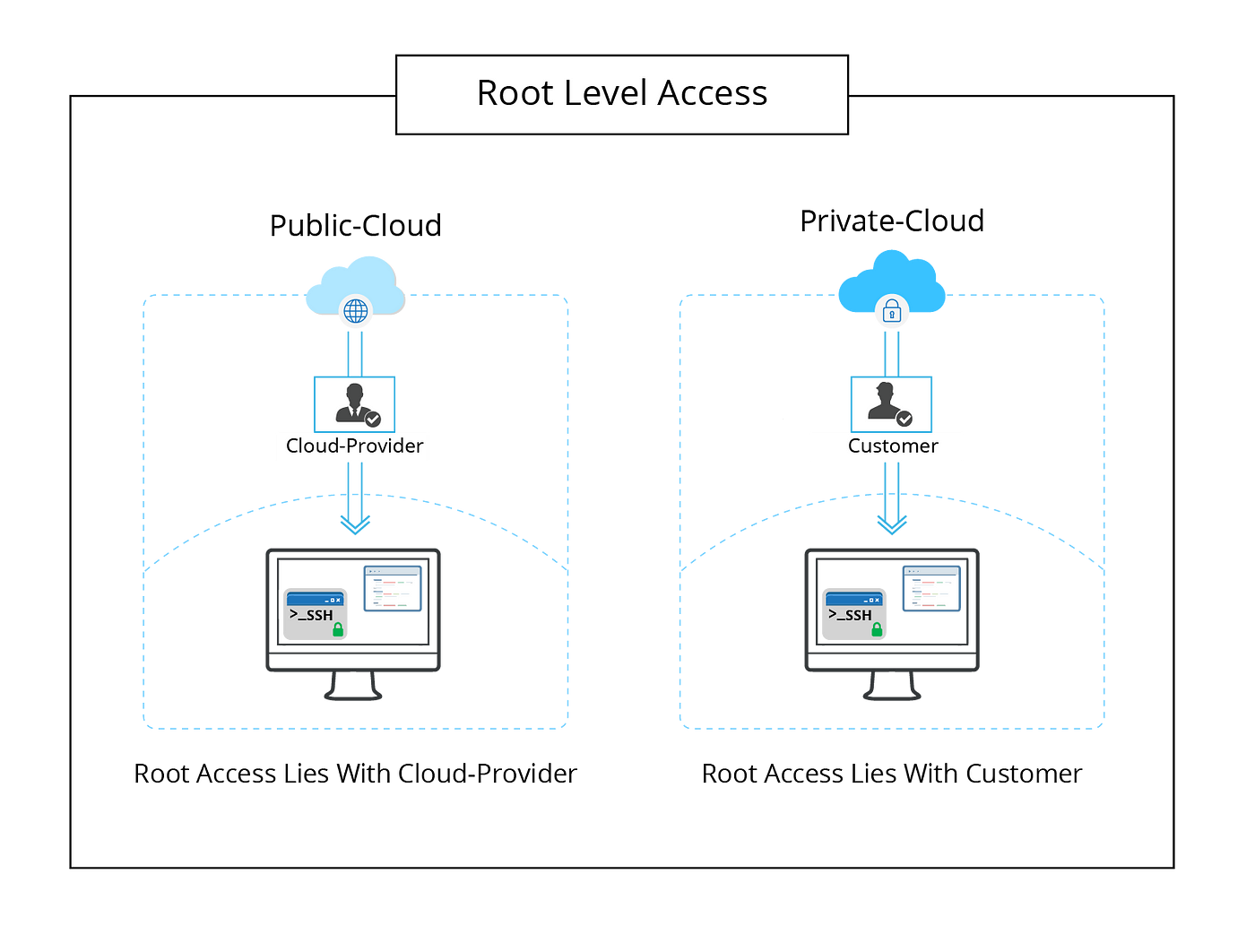 |
| Root Level Access |
Multi-Tenant vs Single Tenant Configurations
Public-Cloud
In a hosted Public-Cloud offering, the applications are configured in a multi-tenant settings by the cloud-provider. Many customers are sharing the same instances of the application. Many a times the underlying applications are not designed to be fully multi-tenant. In those cases, some customized development may be done to the applications or some other configuration hacks are used to enforce multi-tenancy.
Private-Cloud
In a hosted Private-Cloud offering, the application instances are dedicated to one single customer.
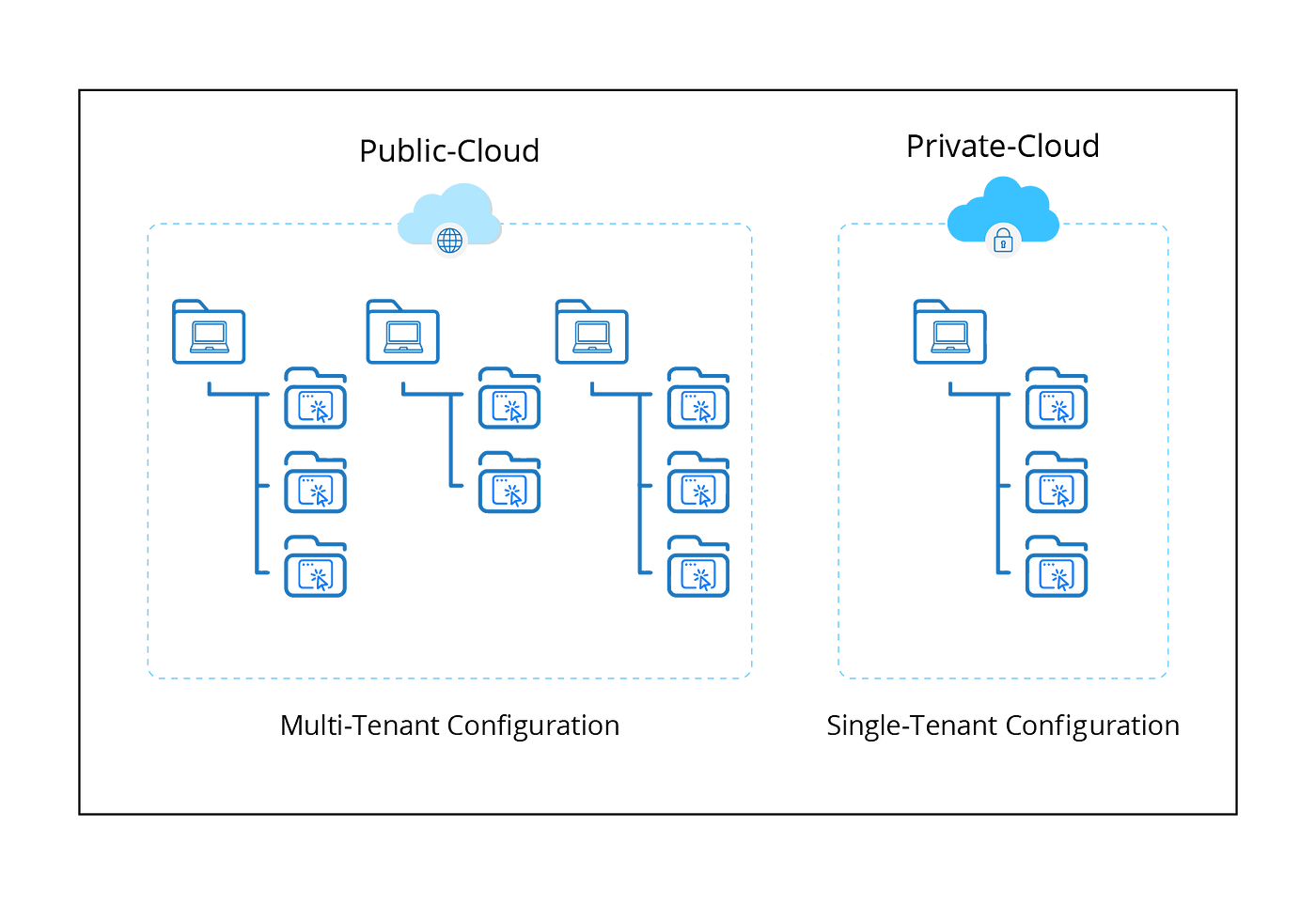 |
| Multi-Tenant vs Single Tenant Configurations |
Shared vs Exclusive Data Repositories
Public-Cloud
In a Public-Cloud offering, the data is stored in shared repositories. If databases are being used, a single database may be holding data for multiple tenant customers.
For file storage, a single volume or folder on a network drive may be holding data for all tenant customers.
To get customers their data, some ‘export’ utilities are provided which extract that customer specific data from the shared repositories and send them in some neutral format.
Private-Cloud.
In a Private-Cloud, customers get exclusive instances of databases or storage folders and volume. That also enables them to take formal application level backups and restores when needed.
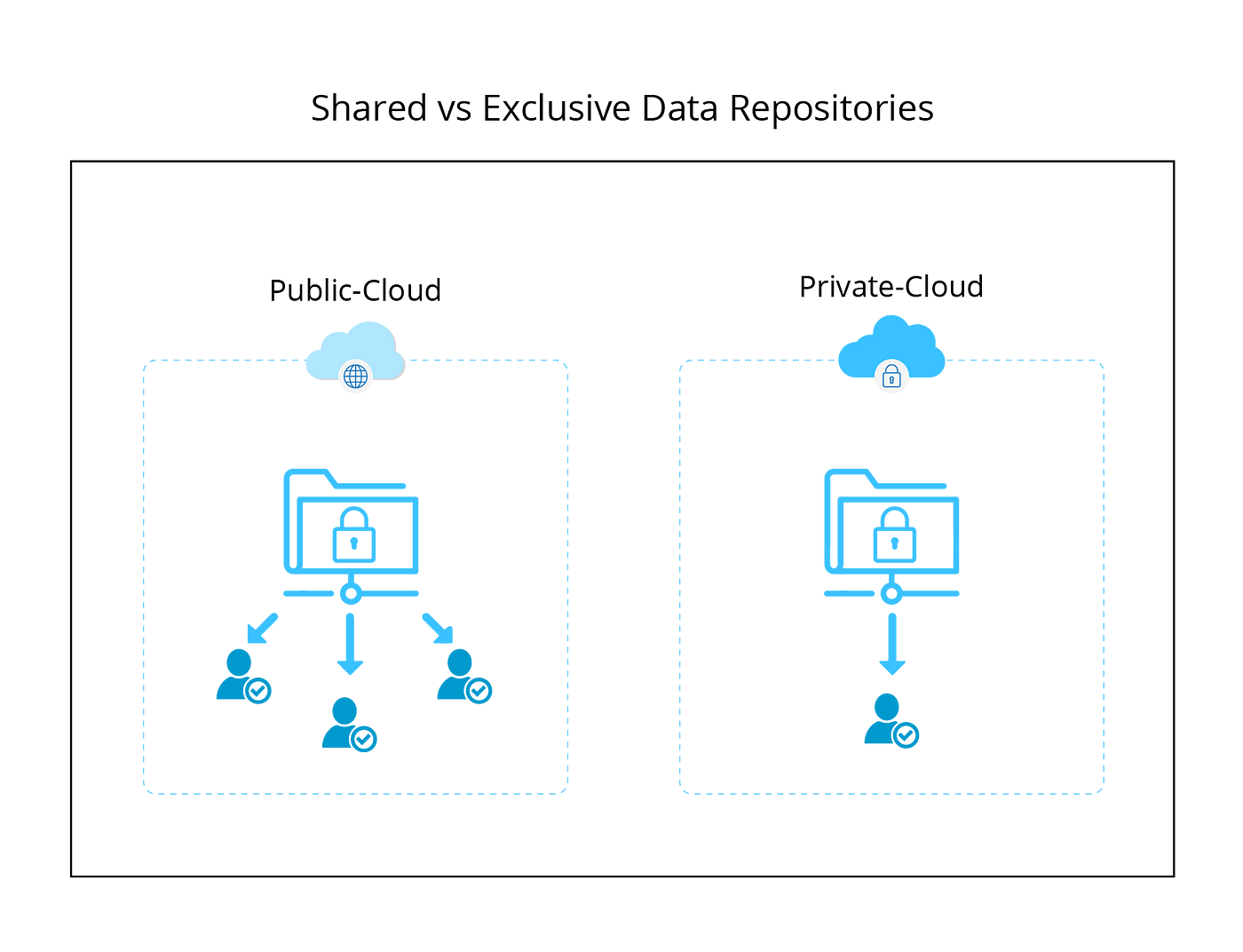 |
| Shared vs Exclusive Data Repositories |
Resource vs Instance based Subscriptions
Public-Cloud
In a public-cloud offering, the cloud-provider offers some resources or combination of resources as service offerings. Many applications will allow a user-based offering to be subscribed. Some other applications will allow a website based offering where many websites are hosted on a single web server.
Private-Cloud
In a private cloud offering, the service offerings are usually full instances of the application or the server. The customer may be allowed to create as many users as it wants. In other cases like a web server, a customer may be able to create as many websites as it wants and so on.
Licensing
Public-Cloud
In a Public-Cloud offering, the cloud-provider takes the license from the original ISV. The license terms may be different for cloud based hosted services. As an example, if the applications are from Microsoft, it requires an SPLA (Service Provider License Agreement) to the purchased by the host which are substantially different pricing from other commercial licenses.
Private-Cloud
In a Private-Cloud offering, the customer puts its own license and is responsible to get the license from the ISV. As is obvious, in that case, its the customer that is responsible for compliance to all licensing requirements. In some settings, such licenses are called BYOL (Bring Your Own License).
It is common for such licenses to be perpetually active as against SPLA or other service provider licenses which usually have monthly payments forever.
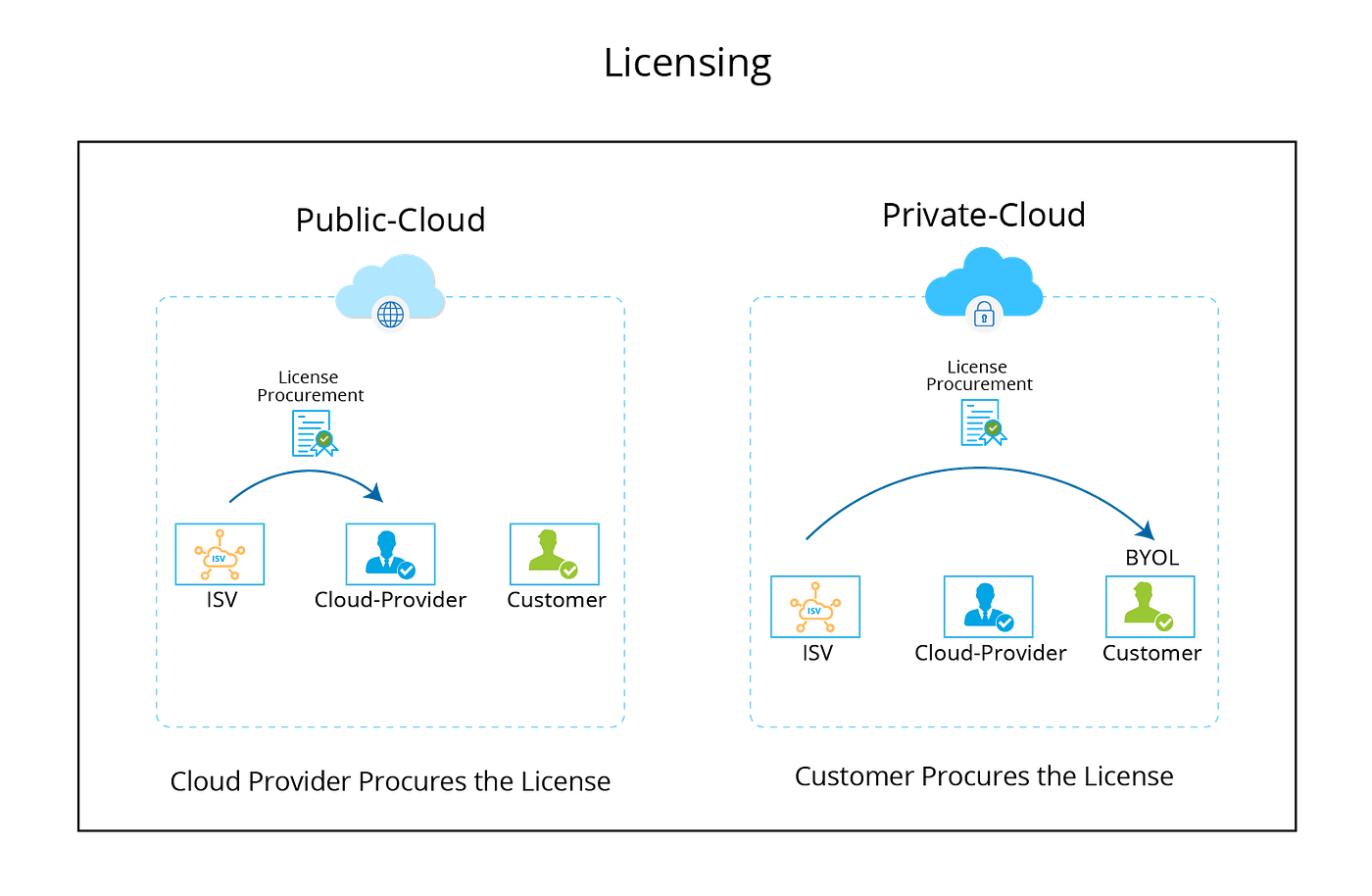 |
| Licensing |
SLA
Public-Cloud
The Cloud-Provider manages all aspects of redundancy, high-availability, scalability, and other SLA related architectural aspects. In case of a service incident, the cloud-provider makes necessary arrangements to continue service for the customers uninterruptedly.
Private-Cloud
The customer itself creates any redundancy, high-availability, scalability and other aspects although it may use some of the features provided by the cloud-provider which are only at the infrastructure level. Typical examples are providing virtual IP addresses, redundant storage devices, layer 2, 3 and 4 load-balancers, application layer gateways and so on.
But when a service level incidence happens, the customer is itself responsible to take measures for continued delivery of service.
Control Panel
Public-Cloud
A control panel is a software tool that provides automated management access to all the control plane actions of the underlying applications. It may provide GUI based interfaces and APIs and will maintain an audit trail of all the changes made.
For public-cloud offerings, the cloud-provider needs to develop a control panel that also supports multi-tenancy and enables customers to be able to self-serve themselves for all the use-cases.
Private-Cloud
In a Private-Cloud setting, the customers are usually left with making their own arrangements for any automation. They may choose to do control-plane actions through remote login or remote desktop connections or through remote access tools like telnet or SSH.
Alternately, the customer can arrange a control panel on their own. At times, the cloud-provider facilitates some control panel tools through their marketplace or ISV partnership programs.
Small Service Providers
Small service providers are in between large cloud-providers and end-customer organizations. They at times purchase private cloud offerings from large cloud-providers and use them to offer SaaS or other public-cloud offerings of their own to their own downstream customers.
Examples are many hosted Microsoft Exchange, web hosting and most SaaS providers.
Examples of Public-Cloud Offerings
Microsoft 365
Microsoft 365 (formerly Office 365) is one of the most common public cloud offerings. This has an offering based on Microsoft Exchange, Active Directory, SharePoint and other related applications from Microsoft all offered as a Public-Cloud offering.
As mentioned above, Microsoft has added extra layers of multi-tenancy to be able to share the same servers and instances among multiple tenant customers. The service offerings are based on user-level subscription bundles. Microsoft itself manages all aspects of redundancy, high-availability, scalability and security etc.
Microsoft has developed a control panel whose access is given to every customer to enable them to manage their cloud based services on their own.
Shared Web Hosting
In such an offering, a single web-server is shared to host websites and web applications from a large number of tenant customers. A control panel is almost always introduced to enable customers to be able to manage their partition on their own using the provided GUI and API based interfaces.
VPS Hosting
VPS hosting requires virtual machines to be offered in the public-cloud. The cloud-provider retains HostOS access while delegates the GuestOS access to respective customers.
Concluding Remarks
Hosting Controller is a control Panel software that supports many higher level applications. For every application that it supports, it offers a public-cloud version with all the features mentioned above. It may also be used by organizations to manage application instances hosted in private clouds offered by cloud-providers. More can be seen on website at http://HostingController.com
To stay in the know with Hybrid Cloud Technologies, follow us on Twitter, LinkedIn, Facebook, subscribe to our YouTube Channel or talk to our Microsoft Enterprise application experts today to discuss your unique needs.
Originally published at https://bog.hostingcontroller.com August 15, 2022.





Post a Comment